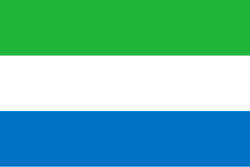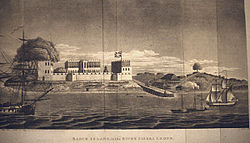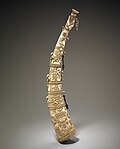Sierra Leone
Sierra Leone is a country in West Africa. Its capital is Freetown. The official language is English.
Republic of Sierra Leone | |
|---|---|
| Motto: | |
| Anthem: | |
![Location of Sierra Leone (dark blue) – in Africa (light blue & dark grey) – in the African Union (light blue) — [Legend]](https://upload.wikimedia.org/wikipedia/commons/thumb/4/4f/Location_Sierra_Leone_AU_Africa.svg/500px-Location_Sierra_Leone_AU_Africa.svg.png) Location of Sierra Leone (dark blue) – in Africa (light blue & dark grey) | |
| Capital and largest city | Freetown |
| Official languages | English |
| |
| Demonym(s) | Sierra Leonean |
| Government | Unitary presidential Constitutional republic |
| Julius Maada Bio | |
| Mohamed Juldeh Jalloh | |
| Jacob Jusu Saffa [1] | |
| Abass Chernor Bundu | |
• Chief Justice | Desmond Babatunde Edwards |
| Independence | |
• from the United Kingdom | 27 April 1961 |
• Republic declared | 19 April 1971 |
| Area | |
• Total | 71,740 km2 (27,700 sq mi) (119th) |
• Water (%) | 1.1 |
| Population | |
• Estimate | 6.3 million (2008 estimate) [1][2][3][4][5][6] |
• 2004 census | 4,976,871 |
• Density | 79.4/km2 (205.6/sq mi) (114th1) |
| GDP (PPP) | 2010 estimate |
• Total | $4.837 billion[2] |
• Per capita | $780[2] |
| GDP (nominal) | 2009 estimate |
• Total | $1.877 billion[2] |
• Per capita | $311[2] |
| Gini (2003) | 62.9 very high |
| HDI (2011) | low · 180th |
| Currency | Leone (SLL) |
| Time zone | UTC+0 (GMT) |
| Driving side | right |
| Calling code | 232 |
| ISO 3166 code | SL |
| Internet TLD | .sl |
1 Rank based on 2007 figures. | |
The country was first made as a place where freed slaves could live. From 1991 until 2000, there was a civil war in Sierra Leone between rebels and the government. The war is now over. Sierra Leone is known for its blood diamonds. These were mined and sold during the civil war. This was in order to buy the weapons for the civil war.[3]
There are 71,740 square kilometres of land in Sierra; In terms of land area it is similar in size to Ireland.
Sierra Leone has relied on mining, especially diamonds, for its economic base. The country is among the largest producers of titanium and bauxite, and a major producer of gold. The country has one of the world's largest deposits of rutile. Sierra Leone is also home to the third largest natural harbour in the world. Shipping from all over the globe goes to Freetown's famous Queen Elizabeth II Quay. Despite this natural wealth, 70% of its people live in poverty.[4]
Sierra Leone is a mostly Muslim country.[5][6][7]
The country has 2,090 known species of higher plants, 147 mammals, 626 birds, 67 reptiles, 35 amphibians, and 99 fish species.
History
In 1672, The Royal African Company built forts on some islands close to Sierra Leone for trading. Slave trading was becoming more popular, so the forts mostly traded humans. In fact, Bunce Island became a popular place to transport slaves to Europe and Americas.[8]
Geography and climate
The country is bordered by Guinea to the north and northeast, Liberia to the south and southeast, and the Atlantic Ocean to the west.[9]
Mount Bintumani reaches 1,948 m (6,391 ft). It is the highest point in the country.
The climate is hot, tropical and humid all year round, with two seasons. The rainy season is from May to November, and the dry season is from December to May.
March & April are the hottest months and daytime temperatures are around 38 °C (100 °F) - 41 °C (106 °F) with a solid 82% humidity. Nighttime temperatures do not vary a lot and may fluctuate by 2 °C - 4 °C.
December and January are preferably the best times to visit Sierra Leone as temperatures and humidity are much lower and reasonable due to the hammattan breeze from the Sahara desert, although afternoon temperatures can still climb up to 40 °C and above, the hammattan breeze stops it from getting too humid, even though it will still be hot, humidity would be can be lowered down to 39%, meaning you'll sweat less during this time than you would when the climate goes back to its original state, so therefore the heat would be more endurable especially around coastal areas.
When the hammattan breeze has lowered the heat and the humidity to its base, the highest average daily temperature in December and January will only reach a maximum of 31 °C (88 °F) and nighttime temperatures will be 24 °C (75 °F), although it can sometimes drop to 21 °C (70 °F) at night, and sometimes in the morning which is the lowest the temperature can get. During this time, humidity is 70% & it is pleasantly warm and enjoyable.
The rainy season from May-November, average temperatures are 27 °C (81 °F) - 29 °C (84 °F) with humidity 95% - 100%. Some days when it doesn't rain, temperatures can climb up to 32 °C (90 °F) and humidity can be moderate around 75%. Rainfall can be torrential, so if you're travelling to Sierra Leone around this time of the year, it is advisable to bring waterproof clothing as it can rain for a whole week without interruption from sunlight.
Largest cities
The largest cities in Sierra Leone are:
- Freetown 1,070,200
- Bo 269,000 [7] Archived 2011-07-20 at the Wayback Machine
- Kenema 158,496 [8]
- Koidu Town 111,800 [9] Archived 2012-09-20 at the Wayback Machine
- Makeni 105,900 [10] Archived 2012-09-20 at the Wayback Machine
Education
Education in Sierra Leone is legally required for all children for six years. A shortage of schools and teachers has made this impossible.[10] Two thirds of the adult population of the country are not able to read.[11] The Sierra Leone Civil War caused the destruction of 1,270 primary schools. In 2001, 67% of all school-age children were out of school.[10] This has been better since the end of the civil war.
The country has three universities: Fourah Bay College, University of Makeni and Njala University. Teacher training colleges and religious seminaries are found in many parts of the country.
Provinces and districts
The Republic of Sierra Leone has five regions the Northern Province, North West Province, Southern Province, the Eastern Province and the Western Area. The first four provinces are divided into 14 districts. The districts are further divided into 149 chiefdoms.
| District | Capital | Area km2 | Province | Population (2004 census)[12] | Population (2008 estimates) |
|---|---|---|---|---|---|
| Bombali District | Makeni | 7,985 | Northern Province | 408,390 | 424,100[13] |
| Koinadugu District | Kabala | 12,121 | 265,758 | ||
| Port Loko District | Port Loko | 5,719 | 455,746 | 483,752[14] | |
| Tonkolili District | Magburaka | 7,003 | 347,197 | 370,425[15] | |
| Kambia District | Kambia | 3,108 | 270,462 | 299,725[16] | |
| Kenema District | Kenema | 6,053 | Eastern Province | 497,948 | 522,656[17] |
| Kono District | Koidu Town | 5,641 | 335,401 | ||
| Kailahun District | Kailahun | 3,859 | 358,190 | 389,253[18] | |
| Bo District | Bo | 5,473.6[19] | Southern Province | 463,668 | 527,131[20] |
| Bonthe District | Mattru Jong | 3,468 | 129,947 | 137,155[21] | |
| Pujehun District | Pujehun | 4,105 | 228,392 | 262,073[22] | |
| Moyamba District | Moyamba | 6,902 | 260,910 | ||
| Western Area Urban District | Freetown | 3,568 | Western Area | 1,272,873 | 1,473,873 |
| Western Area Rural District | Waterloo | 4,175 | 174,249 | 205,400 |
Food and customs
Rice is the staple food of Sierra Leone. It is eaten at nearly every meal daily. The rice is prepared in many ways, and topped with different sauces made from some of Sierra Leone's favorite toppings. These include potato leaves, cassava leaves, crain crain, okra soup, fried fish and groundnut stew.[23]
Along the street of towns and cities one can find snacks such as fresh mangoes, oranges, pineapple, fried plantains, ginger beer, fried potato, fried cassava with pepper sauce; small bags of popcorn or peanuts, bread, roasted corn, or skewers of grilled meat or shrimp.
Poyo is a popular Sierra Leonean drink. It is a sweet, lightly fermented palm wine.[24] Poyo bars are areas of lively informal talk about politics, football, entertainment and other issues.
Sports
Football is by far the most popular sport in Sierra Leone. Children, youth and adult are often seen playing street football across Sierra Leone.
The Sierra Leone national football team, popularly known as the Leone Stars, represents the country in international competitions. It has never qualified for the FIFA World Cup. They were in the 1994 and 1996 African Cup of Nations. Many of the national team footballers are celebrities across Sierra Leone. They are often well known by most of the country's general population. Some well known Sierra Leonean international footballers include Mohamed Kallon, Mohamed Bangura, Rodney Strasser, Ibrahim Teteh Bangura, Alhassan Bangura, Sheriff Suma, Mohamed Kamara, Umaru Bangura and Kei Kamara.
Sierra Leone Media
Fragments of prehistoric pottery from Kamabai Rock Shelter
Bunce Island, 1805, during the period the slave factory was run by John and Alexander Anderson
Bai Bureh, Temne leader of the Hut Tax War of 1898 against British rule
British West African Campaign troops in Freetown, 1914–1916. Published caption: "British expeditionary force preparing to embark at Freetown to attack the German Cameroons, the main object of the attack being the port of Duala. Auxiliary native troops were freely used in African warfare."
Related pages
References
- ↑ "Big shake-up in Sierra Leone's cabinet". Politico SL. 4 May 2021. Retrieved 6 May 2021.
- ↑ 2.0 2.1 2.2 2.3 "Sierra Leone". International Monetary Fund. Retrieved 21 April 2010.
- ↑ "UN targets 'blood diamonds' trade". BBC News. 1 August 2003. http://news.bbc.co.uk/1/hi/world/africa/3117421.stm. Retrieved 28 April 2011.
- ↑ "Sierra Leone Population below poverty line – Economy". Indexmundi.com. 9 January 2012. Retrieved 20 May 2012.
- ↑ 71% of Sierra Leoneans are Muslims « Oluseguntoday's Blog. Oluseguntoday.wordpress.com (13 October 2009). Retrieved on 15 August 2012.
- ↑ Islam In Sierra Leone Information, Videos, Pictures and News Archived 2013-02-08 at the Wayback Machine. Rtbot.net. Retrieved on 15 August 2012.
- ↑ Sama Banya wants Awareness Times to call Tom Nyuma a Buffoon Archived 2014-10-06 at the Wayback Machine. News.sl (18 April 2012). Retrieved on 15 August 2012.
- ↑ "About Sierra Leone: History". UNIPSIL. 2017-03-01. Retrieved 2021-05-20.
- ↑ LeVert, Suzanne (2006). Cultures of the World: Sierra Leone. Marshall Cavendish (published 2007). p. 7. ISBN 978-0-7614-2334-8.
- ↑ 10.0 10.1 "Sierra Leone" Archived 2013-11-02 at the Wayback Machine. 2001 Findings on the Worst Forms of Child Labor. Bureau of International Labor Affairs, U.S. Department of Labor (2002). This article incorporates text from this source, which is in the public domain.
- ↑ "Human Development Report 2009 – Proportion of international migrant stocks residing in countries with very high levels of human development (%)". Hdrstats.undp.org. Archived from the original on 6 June 2009. Retrieved 22 August 2010.
- ↑ "Final Results 2004 population and housing census" (PDF). Statistics Sierra Leone. p. 3. Archived from the original (PDF) on 25 June 2008. Retrieved 9 June 2008.
- ↑ World Gazetteer: Bombali – profile of geographical entity including name variants[dead link] at www.world-gazetteer.com
- ↑ World-gazetteer.com[dead link]
- ↑ World Gazetteer: Tonkolili – profile of geographical entity including name variants[dead link] at www.world-gazetteer.com
- ↑ World Gazetteer: Kambia – profile of geographical entity including name variants[dead link] at www.world-gazetteer.com
- ↑ World Gazetteer: Kenema – profile of geographical entity including name variants[dead link] at www.world-gazetteer.com
- ↑ World Gazetteer: Kailahun – profile of geographical entity including name variants[dead link] at www.world-gazetteer.com
- ↑ "Bo District". Sierra Leone Encyclopedia (UN and Government of Sierra Leone). July 2007. Archived from the original on 28 August 2008. Retrieved 6 June 2008.
- ↑ World Gazetteer: Bo – profile of geographical entity including name variants[dead link] at www.world-gazetteer.com
- ↑ World-gazetteer.com
- ↑ World Gazetteer: Pujehun – profile of geographical entity including name variants Archived 2012-03-25 at the Wayback Machine at www.world-gazetteer.com
- ↑ Massaquoi, Rachel C. J. (2011). Foods of Sierra Leone and Other West African Countries: A Cookbook. AuthorHouse. p. 5. ISBN 9781449081546.
- ↑ Albala, Ken (2011). Food Cultures of the World Encyclopedia. ABC-CLIO. p. 165. ISBN 9780313376276.
Other websites
| Wikimedia Commons has media related to Lua error in Module:Commons_link at line 62: attempt to index field 'wikibase' (a nil value).. |









